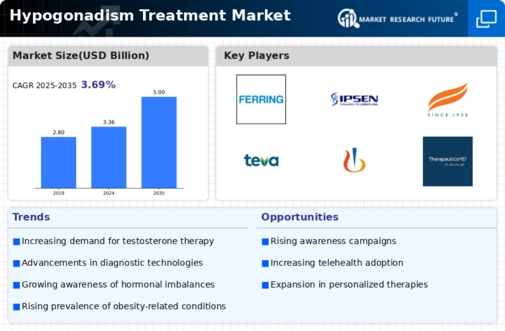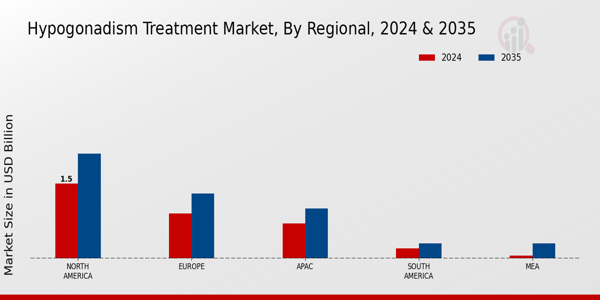Market Growth Projections
The Global Hypogonadism Treatment Market Industry is projected to experience substantial growth over the next decade. With an estimated market value of 3.36 USD Billion in 2024, the industry is anticipated to expand to 5 USD Billion by 2035. This growth reflects a compound annual growth rate (CAGR) of 3.68% from 2025 to 2035. Factors contributing to this upward trajectory include increasing prevalence rates, advancements in treatment options, and growing awareness among patients and healthcare providers. As the market evolves, it is likely to attract significant investment and innovation, further enhancing treatment accessibility and effectiveness.
Growing Awareness and Education
Increased awareness and education regarding hypogonadism are pivotal in driving the Global Hypogonadism Treatment Market Industry. Campaigns aimed at educating healthcare providers and the public about the symptoms and consequences of low testosterone levels are essential. This heightened awareness encourages individuals to seek medical advice and treatment. For instance, initiatives by health organizations have led to improved screening practices, allowing for earlier diagnosis and intervention. As more patients become informed about their health, the demand for effective treatments is expected to rise, supporting the market's growth trajectory with a projected CAGR of 3.68% from 2025 to 2035.
Advancements in Treatment Options
Innovations in treatment modalities are significantly influencing the Global Hypogonadism Treatment Market Industry. The development of new testosterone replacement therapies, including transdermal patches, gels, and long-acting injections, offers patients more choices tailored to their lifestyles. These advancements not only improve patient adherence but also enhance treatment outcomes. For example, the introduction of bioidentical hormone therapies has gained traction due to their perceived safety and efficacy. As these options become more widely available, they are likely to attract a broader patient base, contributing to the market's anticipated growth to 5 USD Billion by 2035.
Increasing Prevalence of Hypogonadism
The rising incidence of hypogonadism globally is a primary driver for the Global Hypogonadism Treatment Market Industry. Factors such as aging populations and lifestyle-related health issues contribute to this trend. For instance, studies indicate that approximately 4 to 5 million men in the United States alone may be affected by low testosterone levels. This growing patient population necessitates effective treatment options, thereby expanding the market. As awareness increases, more individuals seek diagnosis and treatment, further propelling market growth. The Global Hypogonadism Treatment Market is projected to reach 3.36 USD Billion by 2024, highlighting the urgent need for innovative therapies.
Rising Demand for Personalized Medicine
The trend towards personalized medicine is increasingly influencing the Global Hypogonadism Treatment Market Industry. Patients are seeking tailored treatment plans that consider individual health profiles, preferences, and responses to therapy. This shift is prompting healthcare providers to adopt more patient-centric approaches, including genetic testing and hormone level assessments. As a result, the market is witnessing a surge in demand for customized treatment options that enhance efficacy and minimize side effects. The focus on personalized care is expected to drive market growth, as patients are more likely to adhere to treatments that align with their specific needs.
Regulatory Support for Treatment Approvals
Regulatory bodies play a crucial role in shaping the Global Hypogonadism Treatment Market Industry through the approval of new therapies. Streamlined approval processes for testosterone replacement therapies have facilitated quicker access to innovative treatments. For example, the U.S. Food and Drug Administration has expedited the review of several testosterone products, enhancing market dynamics. This regulatory support not only encourages pharmaceutical companies to invest in research and development but also ensures that patients have access to safe and effective treatment options. As a result, the market is poised for growth, driven by the introduction of new therapies that meet regulatory standards.















